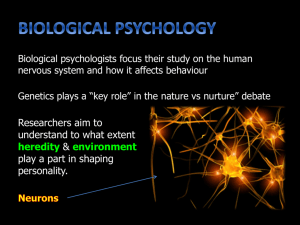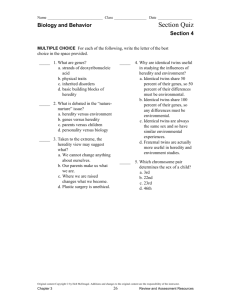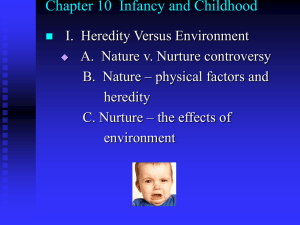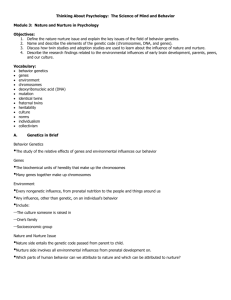Heredity: Our Genetic Background
advertisement
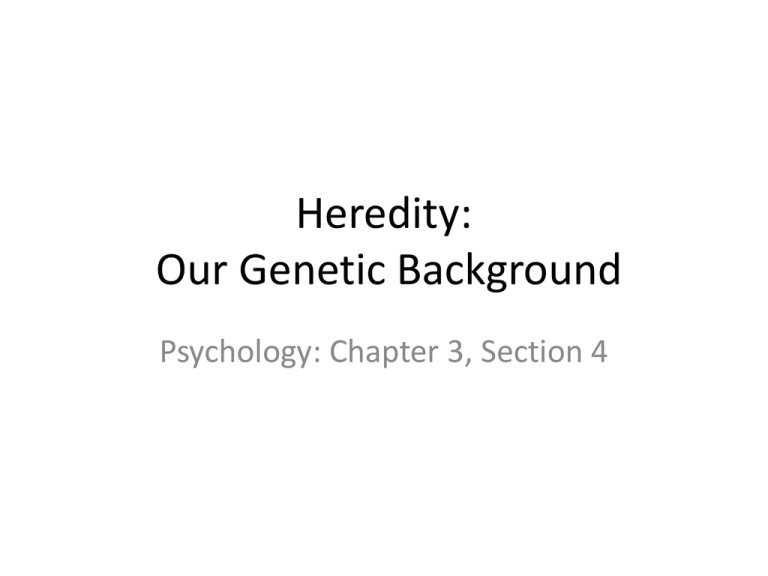
Heredity: Our Genetic Background Psychology: Chapter 3, Section 4 Heredity: Our Genetic Background • Heredity is the transmission of characteristics from parents to offspring • The traits we inherit help shape our behavior • Shyness, leadership ability, aggressiveness, even an interest in arts and crafts are influenced by heredity (while environment also plays a big role) • Psychological disorders, such as depression, schizophrenia, bipolar disorder and alcoholism are also affected by heredity This chart seems to indicate that the closer someone is related to someone with schizophrenia, the more likely that person is to develop a similar diagnosis Genes and Chromosomes • Genes are the basic building blocks of heredity • Genes match up in pairs, one gene in each pair from each parent. As these genes pair up, traits are determined. Genes and Chromosomes • Genes are found in threadlike structures called chromosomes • Chromosomes are composed of deoxyribonucleic acid (DNA) • DNA looks like a twisting rope ladder (called a double helix) Genes are the building blocks of chromosomes DNA: The Genetic Code •The threadlike molecules of DNA that make up chromosomes contain the codes for the development of particular traits. •Each chromosome has more than 1000 genes. •The rungs in the ladder form the genetic code that causes the organism to develop certain traits, and can be the source of some mutations Genes and Chromosomes • Most normal human cells have 46 chromosomes, organized into 23 pairs • In each of the 23 pairs, one chromosome comes from the father and one from the mother • These chromosomes contain instructions for traits. • That mixing of chromosomes is why you may look and act a little like your mother and also like your father Genes and Chromosomes • 22 out of 23 of the chromosomes are the same for both males and females • The 23rd pair is the sex chromosome, determining whether we are to be male or female • In females, both chromosomes are in the shape of an X, so they are both called X chromosomes (XX) • In males, one of the chromosomes looks like a Y, so the males are said to have XY • This X or Y is contributed by the father; he determines the sex of the child In the case of these 23 chromosome pairs, this offspring is a boy, as he has the larger x chromosome matched with the smaller y chromosome in the 23rd pair Genes and Chromosomes • Occasionally, there is a mutation where there are not 46 chromosomes in each cell • If there is an extra chromosome on the 21st pair, then the baby will be born with Down syndrome. • Down syndrome usually means there will be some level of mental retardation, with some heart and respiratory problems People with Down syndrome have some similar facial features The Nature- Nurture Debate • For many years, people have debated about the role of biology in determining who we are as people • This is often called the Nature-Nurture debate • Nature refers to what people inherit biologically from their parents • Nurture refers to how a person is raised– living conditions, parental involvement, educational opportunities, etc. The Nature- Nurture Debate • Most psychologists agree that influences from both nature and nurture determine our psychological traits • There may be someone who has the genetic potential to write a brilliant novel, but won’t because she never gets the chance to read or write • Heredity is not destiny, but it is a predisposition within an environment Nature vs. Nurture We inherit our physical, intellectual, and emotional characteristics from our ancestors, but these things are also greatly affected by where/ how we live. Kinship Studies • The most common way to figure out the roles of heredity and environment is to do kinship studies • Kinship is based on degree people are related – Identical twins share 100% of their genes – A parent and child shares 50% of their genes (1/2) – Brothers and sisters also share 50% (1/2) – Aunts/ uncles share 25% with their nieces and nephews (1/4) – First cousins share 12.5% (1/8) Kinship Studies • Psychologists can look at traits in individuals and see how they compare with relatives • Two common types of kinship studies are twin studies and adoptee studies Identical twins share 100% of their genetic code, whereas fraternal twins are basically just like any other siblings Twin Studies • Studying identical and fraternal twins can show a lot about nature vs. nurture, as identical twins share 100% of the same genetic makeup • If identical twins are more similar on a certain trait than fraternal twins, then that could be an indication that that trait is influenced by genetics Twin Studies • Some traits that do seem to be more similar between identical than fraternal twins are shyness, activity level, irritability, sociability, and overall happiness • Autism is highly linked by genetics– if one identical twin has autism, there is a 96% chance the other has autism. In fraternal twins, there is a 24% chance. Adoptee Studies • One problem with twin studies is that identical twins tend to also be raised in the same environment and treated similarly, so that complicates the nature/ nurture discussion • But if twins were adopted, then they would have different environments but still the same genetics Twins Reared Apart • It can therefore be useful to study twins who were raised apart from each other • In such studies, researchers have found that intelligence, following rules, risk avoidance, aggression, and leadership traits were very similar in twins, even when reared apart • They also may sit or stand very similarly, and have similar tastes in clothing • Twins: Is it All in the Genes? https://youtube.com/watch?v=Wd5Y3-F79LY Assessment • Complete the three questions on page 72




